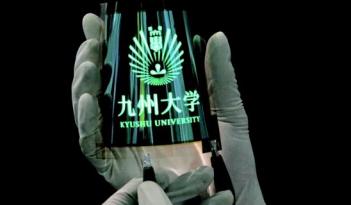In December 2012 we posted about Japan's Kyushu University new rare-metal free fluorescent OLED emitter materials that achieve 100% emission efficiency. Now the International Society for Optics and Photonics (SPIE) released a new video featuring Kyushu's professor Chihaya Adachi. Following a rather long introduction into his lab and his own biography, professor Adachi explains their thermally activated delayed fluorescence (TADF) technology (also called hyperfluorescence).
Adachi says that are seeking a commercialization partner, and they still need to study the degradation mechanism and expand the emission spectrum. Towards the end of this video you can view a couple of prototype monochrome (green) panels that use their new emitters.

Comments
In April 2004, we entered into a Contract Research Agreement with the Chitose Institute of Science and Technology of Japan (CIST). Under that agreement, we funded a research program headed by Dr. Chihaya Adachi relating to high-efficiency OLED materials and devices. We were granted exclusive rights to all intellectual property developed under this program. This relationship with CIST ended in March 2006 when Dr. Adachi transferred to Kyushu University. However, we have continued our relationship with Dr. Adachi under a separate consulting arrangement that currently runs through March 2007, and we are in discussions with Dr. Adachi to extend the arrangement beyond that date.


Just FYI Professor Chihaya Adashi ,has worked with UDC for years and you will find his name on many UDC patents. They continued to have relationship with Professor Adachi under a separate consulting arrangement.